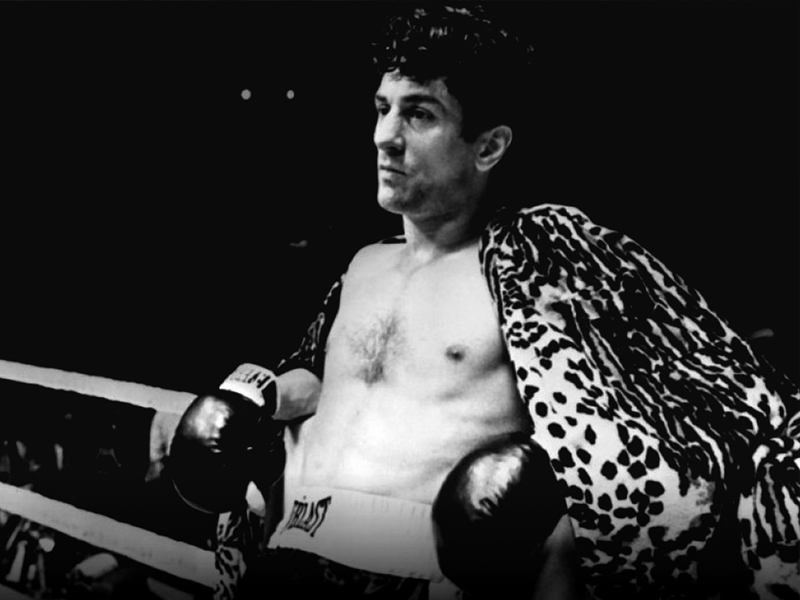
The life of boxer Jake LaMotta, whose violence and temper that led him to the top in the ring destroyed his life outside of it.
Jake La Motta: Go get ‘em, champ. [starts shadowboxing] I’m the boss, I’m the boss, I’m the boss, I’m the boss, I’m the boss... (I’m the) boss, boss, boss, boss, boss, boss.
Jake La Motta: I remember those cheers,
They still ring in my ears,
And for years they’ll remain in my thoughts.
Cuz one night I took off my robe,
And what’d I do? I forgot to wear shorts.
I recall every fall, every hook, every jab,
The worst way a guy can get rid of his flab,
As you know, my life was a jab.
Though I’d rather hear you cheer
When I delve into Shakespeare …
“A horse, a horse, my Kingdom for a horse,”
I haven’t had a winner in six months.
And though I’m no Olivier,
If he fought Sugar Ray, he would say
That the thing ain’t the ring, it’s the play.
So give me a stage
Where this bull here can rage,
And though I can fight,
I’d much rather recite.
That’s entertainment!
That’s entertainment.
“I put everything I knew and felt into that film and I thought it would be the end of my career. It was what I call a kamikaze way of making movies: pour everything in, then forget all about it and go find another way of life.
There were a number of boxing movies coming out at that time: Rocky II (1979), which was a blockbuster movie in bright colours, strong reds and blues; The Main Event (1979), The Champ (1979) and even one about a boxing kangaroo called Matilda! All naturally in colour. But the one use of colour in a fight sequence that had really impressed me was the flashback in John Ford's The Quiet Man (1952), when Wayne looks down and realizes he's killed his opponent, and I'll never forget the vibrance of his emerald green trunks. During preparations for Raging Bull, we shot some 8 mm while Bobby [Robert De Niro] was training in a gym and I remember we were looking at this, projected on the back of a door in my apartment on 57th Street, and Michael Powell was sitting on the floor watching it with us. Suddenly Michael said, ‘There's something wrong: the gloves shouldn't be red.’ (...) [H]e was right about the boxing footage, and our cinematographer Michael Chapman also pointed out how colour was detracting from the images. (...) We said, no, it's too pretentious to use black and white now. But then it clicked in my mind that colour wasn't going to last anyway – the film stock was subject to rapid fading.
In Raging Bull, the camera almost always stays in the ring with Jake. When I'd seen boxing matches between double features on Saturday afternoons as a kid, it was always from the same angle, and that's why I became so bored. The only person who had the right attitude about boxing in the movies for me was Buster Keaton.
The sound on Raging Bull was particularly difficult because each punch, each camera click and each flashbulb was different. The sound effects were done by Frank Warner, (...) he used rifle shots and melons breaking, but the wouldn't tell us what many of the effects were; he became very possessive and even burnt them afterwards so nobody else could use them.
Bob is a very generous actor and he will be even stronger when the other guy's in close-up. (...) And he really gets other actors to act in his scenes. For example, when Jake asks Joey, ‘Did you fuck my wife?’ I had written a seven-page scene, the only full-length dialogue in the film. When he asks the question, you see Joey asking him back, ‘What, how could you say that?’ I told Bob I wasn't getting enough reaction from Joe Pesci. He told me to roll the camera again, and then said, ‘Did you fuck your mother?’ When you see the film again, look at Joe's reaction!
The only way to do it [the final ‘I coulda been a contender’ scene from On the Waterfront (1954) with “De Niro playing Jake La Motta playing Marlon Brando playing Terry Malone”] was to make it so cold that you concentrate on the words and you feel him finally coming to some sort of peace with himself in front of that mirror. And that's the way we did it, in nineteen takes. Sometimes Jake La Motta himself would really act it out in a very strong way which was quite heartbreaking, and Bobby did it that way three times. It was the last day of shooting, and I think we used take 13 in the end. One reviewer in America wrote that it's the most violent scene in the film. When he says in the mirror, ‘It was you, Charlie,’ is he playing his brother, or putting the blame on himself? It's certainly very disturbing to me.”
Martin Scorsese1
- 1Martin Scorsese, David Thompson & Ian Christie (eds.), Scorsese on Scorsese (Updated Edition), (London: Faber and Faber, 1996).

